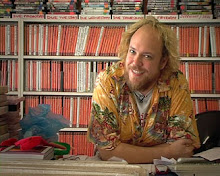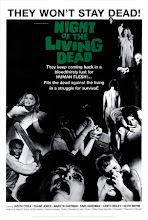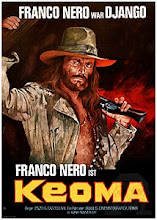 Blood Thirst
Blood Thirst
Our first Halloween treat tonight is the last in our Filipino horror season, Blood Thirst. From the clothes, hairstyles and black and white film grain it looks like it was filmed in the Philippines by an American production company around the mid Sixties, but wasn’t released until 1971 on the bottom of a double bill with British vampire movie Bloodsuckers (1970). Even in 1971 Blood Thirst would have seemed like an anachronistic curio – quaint, and for the most part uneventful, until the ludicrous ending’s payoff where we see the film’s chewed bubblegum-faced monster. Then, and only then, can I say, baby, all is forgiven.
 Chubby Vic Diaz (and let’s face it, it’s not a Philippines B film without the seedily lovable Vic) plays Inspector Ramos, a Makati policeman on the trail of missing hostesses from the Barrio Club, a downbeat tourist trap run by the suspicious Senor Calderon. When the girls turn up hanging upside down and drained of blood from cuts on their arms, he sends for his old friend from the States, a cop named Adam Rourke who, as a New Yorker, is obviously used to seeing ritual murders. Posing as an “Ugly American” on a writing assignment, he goes undercover at the Barrio Club, asks one too many questions, cracks jokes like a proto-Arnie while shooting a would-be assassin, and turns out to be an ill-tempered ladies man with his eye on every Caucasian-looking woman in Manila. Just like every sleazy Hawaiian shirted white guy on a Manila hayride.
Chubby Vic Diaz (and let’s face it, it’s not a Philippines B film without the seedily lovable Vic) plays Inspector Ramos, a Makati policeman on the trail of missing hostesses from the Barrio Club, a downbeat tourist trap run by the suspicious Senor Calderon. When the girls turn up hanging upside down and drained of blood from cuts on their arms, he sends for his old friend from the States, a cop named Adam Rourke who, as a New Yorker, is obviously used to seeing ritual murders. Posing as an “Ugly American” on a writing assignment, he goes undercover at the Barrio Club, asks one too many questions, cracks jokes like a proto-Arnie while shooting a would-be assassin, and turns out to be an ill-tempered ladies man with his eye on every Caucasian-looking woman in Manila. Just like every sleazy Hawaiian shirted white guy on a Manila hayride.
 His eyes settle on both Inspector Ramos’ adopted sister Sylvia, who resists Rourke’s questionable charms until she can no longer stand it, and on the Barrio Club’s featured attraction, the exotic dancer and blonde Peruvian bombshell named Serena. It seems her beauty is more than skin-deep: it’s vein-deep, and may be the still-beating heart of a blood cult of Mayan or Incan origin – or older, we’re never quite sure – in which Golden Goddesses are kept eternally youthful with the blood of club hostesses. The Golden Goddess theory may explain, though not fully, why Serena looks more Swedish than Peruvian, but definitely won’t point to where she’s stashed her stewardess uniform for Scandinavian Airlines.
His eyes settle on both Inspector Ramos’ adopted sister Sylvia, who resists Rourke’s questionable charms until she can no longer stand it, and on the Barrio Club’s featured attraction, the exotic dancer and blonde Peruvian bombshell named Serena. It seems her beauty is more than skin-deep: it’s vein-deep, and may be the still-beating heart of a blood cult of Mayan or Incan origin – or older, we’re never quite sure – in which Golden Goddesses are kept eternally youthful with the blood of club hostesses. The Golden Goddess theory may explain, though not fully, why Serena looks more Swedish than Peruvian, but definitely won’t point to where she’s stashed her stewardess uniform for Scandinavian Airlines.
 And so to the “horror” element: a blood cult, a bubblegum faced monster waving a knife at a young girl strapped to an altar. And…that’s pretty much it. It’s an odd film reminiscent of an undercooked episode of Hawaii Five-O minus the pineapple, that’s more interested in its mystery angle than the gore or supernatural elements. It also feels empty, and not just plot-wise – Blood Thirst is the only film I can recall that makes a city of over 10 million people seem uninhabited. Still, it’s an interesting 73 minutes, more for what it is than what it does: a cheapo spookshow which predates the John Ashley/Roger Corman deluge of Philippine horrors by several years. And, to be fair, it’s not every day you see a monster clobbered to death by an undercover cripple’s fake leg.
And so to the “horror” element: a blood cult, a bubblegum faced monster waving a knife at a young girl strapped to an altar. And…that’s pretty much it. It’s an odd film reminiscent of an undercooked episode of Hawaii Five-O minus the pineapple, that’s more interested in its mystery angle than the gore or supernatural elements. It also feels empty, and not just plot-wise – Blood Thirst is the only film I can recall that makes a city of over 10 million people seem uninhabited. Still, it’s an interesting 73 minutes, more for what it is than what it does: a cheapo spookshow which predates the John Ashley/Roger Corman deluge of Philippine horrors by several years. And, to be fair, it’s not every day you see a monster clobbered to death by an undercover cripple’s fake leg.
Adam: There’s a killer on the loose… a homicidal maniac with delusions of ancient history. Now, can I use your phone?
 Robert Wilson Mercy, the smug big-chinned former stuntman and bit player who plays our Ugly American hero, has made his presence felt on the net recently, leaving some outrageous claims in unsuspecting chatrooms: that he made more lost films in the Philippines with director Newt Arnold, who he describes as one-eyed and with a malformed hand; that he was offered the role of James Bond in a serious version of Casino Royale – but he was making a crappy B-film in Manila at the time and couldn’t get out of the contract; and that he’s stalking the producers of the next Bond film offering his services as Daniel Craig’s nemesis. I say to Robert Wilson Mercy: the world may have gotten Woody Allen as James Bond instead, but we still have your career’s crowning glory, the 1971 Blood Thirst.
Robert Wilson Mercy, the smug big-chinned former stuntman and bit player who plays our Ugly American hero, has made his presence felt on the net recently, leaving some outrageous claims in unsuspecting chatrooms: that he made more lost films in the Philippines with director Newt Arnold, who he describes as one-eyed and with a malformed hand; that he was offered the role of James Bond in a serious version of Casino Royale – but he was making a crappy B-film in Manila at the time and couldn’t get out of the contract; and that he’s stalking the producers of the next Bond film offering his services as Daniel Craig’s nemesis. I say to Robert Wilson Mercy: the world may have gotten Woody Allen as James Bond instead, but we still have your career’s crowning glory, the 1971 Blood Thirst.
Tombs Of The Blind Dead
Now to a duo of the undead courtesy of Amando de Ossorio, Spanish genre filmmaker who entered the surprisingly tolerant Franco-era Seventies specializing in an increasingly lurid series of sex-and-blood drenched shockers for the international market. He made the voodoo splatter of Night Of The Sorcerors and the Lovecraftian aquatic terror of When The Screaming Stops, but is best remembered as the Spanish King of the Zombies.
The Blind Dead series is de Ossorio’s answer to George Romero’s Night Of The Living Dead. But instead of aping Romero’s pale-faced store mannequins as his fellow countryman Jorge Grau did in The Living Dead In Manchester Morgue, de Ossorio goes for an unique interpretation – the resurrected skeletons of the Knights Templar. You heard it – the Satan-worshipping renegade monks are now skeletons in rotting cowls, unable to see, not because of their skulls’ empty eye sockets, but because their eyes had been pecked out by crows upon their execution. Curiously, they can still hear – and their beards are still intact. Happy days.
Former “schoolfriends” Betty and Virginia – and I repeat, “schoolfriends” – bump into each other on holiday in Portugal. Virginia’s husband Roger suggests a camping trip, just the three of them, but when the sexual tension between Roger and Betty becomes unbearable, Virginia jumps off the train and spends the night in a nearby crumbling Abbey. It just happens to be the last resting place (if you can call it that) of the zombie Knights, who rise from their centuries-old graves guided by the sounds of Virginia’s transistor radio – and her screams. Rule One of the Blind Dead films: shut the hell up. Rule Two: (pause) Well done.
By the time Betty and Roger head back, Virginia’s lifeless body has been found almost torn to pieces. The coroner’s verdict: bone-idle hands do the Devil’s work. With the help of shady criminal Pedro and his moll Maria, they retrace her last steps to the monastery, where they uncover the fog-shrouded secret of the Templar’s ongoing success, and discover the only way to avoid the Blind Dead is to be very, very quiet. Meanwhile a naked and blood-covered Virginia awakens on the slab and, as more of a vampire than zombie, goes on a neck-chewing spree! Does it make sense? No, but I think we’re missing the point. It’s the wild, tangential, chaotic nature at the core of Spanish horror that gives it the power to shock, not to mention confuse.
De Ossorio sprinkles the proceedings with confounding yet eerily effective images, like the skeletal knights riding across the Spanish countryside on horses in slow motion like rotting Horsemen of the Apocalypse, and naturally Betty’s escape from the lumbering eyeless dead accompanied by a single deafening heartbeat. The ending on the train – hilariously grim and quasi-apocalyptic, and with more than a nod to Night Of The Living Dead – is a fitting “huh?” to its previous eighty-something minutes.
We have to remember it’s 1971, and the zombie genre as we know it is in its infancy, which explains the phenomenal success of Tombs Of The Blind Dead. It was immediately followed by three sequels starting with Return Of The Evil Dead the following year. The Blind Dead’s crumbling monks have often been imitated by fellow filmmakers but de Ossorio’s Templars certainly set the template for weird undead Euro-horror. After the break we present the third in the series, Horror Of The Zombies, but for now, the original, the startling, the blinding: Tombs Of The Blind Dead.
 Horror Of The Zombies
Horror Of The Zombies
The Blind Dead leave the sanctuary of the Templar’s crumbling monastery for the third in the series, the floating fright-fest Horror of The Zombies (aka The Ghost Galleon). If there was ever a film that’s rooted firmly in the decade from which it sprung, it’s this one. Oh, and Saturday Night Fever, but this is 1974: pre-disco, and post-taste.
Now, if we’ve all forgotten just how senselessly ugly Seventies fashions were, the opener will bring it all kicking and screaming back to us. It’s at a swimwear photo shoot, where top model Noemi is looking for her missing girlfriend. She’s taken to a secret location by photo-frau Lillian (Maria Perschy) where the great mystey is revealed – her girlfriend Cathy and another model are out in the middle of the ocean as part of an elaborate publicity stunt to promote a weather-controlled boat, cooked up by cocky financier Howard Tucker (Jack Taylor).
Unfortunately for the girls, the fog rolls in (although, being the Seventies, everyone is huffing away on cigarettes and cigars, so how would you notice), and an ancient galleon, seemingly abandoned with rags for sails, floats into view. The girls radio the news of the Ghost Galleon back to base; the resident token egghead Professor Gruber goes a little strange, and despite his rigorous scientific training, suggests the legendary Ghost Galleon is from a another dimension outside of time and space. Clearly a huge fan of Eric von Daniken, Gruber seems to have read one too many supermarket paperbacks on the Bermuda Triangle, but, like I said, it’s the Seventies – we ALL read Von Daniken. The girl’s are here, he reasons, but they’re not, and they won’t be coming back. Nothing is real – the ship, the fog, you or I... A philosophical paradox, for sure, but the real mystery is this: how de Ossorio stretches such a flimsy premise to feature length truly defies all scientific explaination.
So of course they all go looking for the Galleon and the missing bikinis, or maybe Howard Tucker wants his speedboat back. Cue more fog, and the resurrected skeletons of the Knights Templar rising from their onboard coffins. We soon discover on a 16th Century boat, there really is nowhere to run. Or, you could swim, but wait for the water-logged ending to drown that theory. “Preposterous” is the key word here – de Ossorio asks a great deal of his viewers to suspend belief when what amounts to little more than chicken bones drags a fully grown woman down a flight of stairs to her complete and utter dismemberment.
Horror Of The Zombies features the two most popular stars in Spanish horror: Austrian-born Maria Perschy, and American expatriate Jack Taylor who starred in a string of no-budget shockers for Jess Franco and decided he couldn’t go home ever again. And yet Horror Of The Zombies was the least successful of the Blind Dead quartet. Perhaps the film strayed too far from the formula, although how could you go wrong: girls in bikinis on a boat with zombies? Despite its limited scope, micro-cast and tendency to be stage-bound, it’s still an entertaining exercise in tension, atmospheric and illogic, and the empty eye sockets of the Knights Templar are always a welcome sight.
All I can say now is “Welcome aboard” for a cruise into another dimension…of TERROR!…with the 1974 Horror Of The Zombies.
 Chubby Vic Diaz (and let’s face it, it’s not a Philippines B film without the seedily lovable Vic) plays Inspector Ramos, a Makati policeman on the trail of missing hostesses from the Barrio Club, a downbeat tourist trap run by the suspicious Senor Calderon. When the girls turn up hanging upside down and drained of blood from cuts on their arms, he sends for his old friend from the States, a cop named Adam Rourke who, as a New Yorker, is obviously used to seeing ritual murders. Posing as an “Ugly American” on a writing assignment, he goes undercover at the Barrio Club, asks one too many questions, cracks jokes like a proto-Arnie while shooting a would-be assassin, and turns out to be an ill-tempered ladies man with his eye on every Caucasian-looking woman in Manila. Just like every sleazy Hawaiian shirted white guy on a Manila hayride.
Chubby Vic Diaz (and let’s face it, it’s not a Philippines B film without the seedily lovable Vic) plays Inspector Ramos, a Makati policeman on the trail of missing hostesses from the Barrio Club, a downbeat tourist trap run by the suspicious Senor Calderon. When the girls turn up hanging upside down and drained of blood from cuts on their arms, he sends for his old friend from the States, a cop named Adam Rourke who, as a New Yorker, is obviously used to seeing ritual murders. Posing as an “Ugly American” on a writing assignment, he goes undercover at the Barrio Club, asks one too many questions, cracks jokes like a proto-Arnie while shooting a would-be assassin, and turns out to be an ill-tempered ladies man with his eye on every Caucasian-looking woman in Manila. Just like every sleazy Hawaiian shirted white guy on a Manila hayride. His eyes settle on both Inspector Ramos’ adopted sister Sylvia, who resists Rourke’s questionable charms until she can no longer stand it, and on the Barrio Club’s featured attraction, the exotic dancer and blonde Peruvian bombshell named Serena. It seems her beauty is more than skin-deep: it’s vein-deep, and may be the still-beating heart of a blood cult of Mayan or Incan origin – or older, we’re never quite sure – in which Golden Goddesses are kept eternally youthful with the blood of club hostesses. The Golden Goddess theory may explain, though not fully, why Serena looks more Swedish than Peruvian, but definitely won’t point to where she’s stashed her stewardess uniform for Scandinavian Airlines.
His eyes settle on both Inspector Ramos’ adopted sister Sylvia, who resists Rourke’s questionable charms until she can no longer stand it, and on the Barrio Club’s featured attraction, the exotic dancer and blonde Peruvian bombshell named Serena. It seems her beauty is more than skin-deep: it’s vein-deep, and may be the still-beating heart of a blood cult of Mayan or Incan origin – or older, we’re never quite sure – in which Golden Goddesses are kept eternally youthful with the blood of club hostesses. The Golden Goddess theory may explain, though not fully, why Serena looks more Swedish than Peruvian, but definitely won’t point to where she’s stashed her stewardess uniform for Scandinavian Airlines.  And so to the “horror” element: a blood cult, a bubblegum faced monster waving a knife at a young girl strapped to an altar. And…that’s pretty much it. It’s an odd film reminiscent of an undercooked episode of Hawaii Five-O minus the pineapple, that’s more interested in its mystery angle than the gore or supernatural elements. It also feels empty, and not just plot-wise – Blood Thirst is the only film I can recall that makes a city of over 10 million people seem uninhabited. Still, it’s an interesting 73 minutes, more for what it is than what it does: a cheapo spookshow which predates the John Ashley/Roger Corman deluge of Philippine horrors by several years. And, to be fair, it’s not every day you see a monster clobbered to death by an undercover cripple’s fake leg.
And so to the “horror” element: a blood cult, a bubblegum faced monster waving a knife at a young girl strapped to an altar. And…that’s pretty much it. It’s an odd film reminiscent of an undercooked episode of Hawaii Five-O minus the pineapple, that’s more interested in its mystery angle than the gore or supernatural elements. It also feels empty, and not just plot-wise – Blood Thirst is the only film I can recall that makes a city of over 10 million people seem uninhabited. Still, it’s an interesting 73 minutes, more for what it is than what it does: a cheapo spookshow which predates the John Ashley/Roger Corman deluge of Philippine horrors by several years. And, to be fair, it’s not every day you see a monster clobbered to death by an undercover cripple’s fake leg. Robert Wilson Mercy, the smug big-chinned former stuntman and bit player who plays our Ugly American hero, has made his presence felt on the net recently, leaving some outrageous claims in unsuspecting chatrooms: that he made more lost films in the Philippines with director Newt Arnold, who he describes as one-eyed and with a malformed hand; that he was offered the role of James Bond in a serious version of Casino Royale – but he was making a crappy B-film in Manila at the time and couldn’t get out of the contract; and that he’s stalking the producers of the next Bond film offering his services as Daniel Craig’s nemesis. I say to Robert Wilson Mercy: the world may have gotten Woody Allen as James Bond instead, but we still have your career’s crowning glory, the 1971 Blood Thirst.
Robert Wilson Mercy, the smug big-chinned former stuntman and bit player who plays our Ugly American hero, has made his presence felt on the net recently, leaving some outrageous claims in unsuspecting chatrooms: that he made more lost films in the Philippines with director Newt Arnold, who he describes as one-eyed and with a malformed hand; that he was offered the role of James Bond in a serious version of Casino Royale – but he was making a crappy B-film in Manila at the time and couldn’t get out of the contract; and that he’s stalking the producers of the next Bond film offering his services as Daniel Craig’s nemesis. I say to Robert Wilson Mercy: the world may have gotten Woody Allen as James Bond instead, but we still have your career’s crowning glory, the 1971 Blood Thirst.






















































































No comments:
Post a Comment